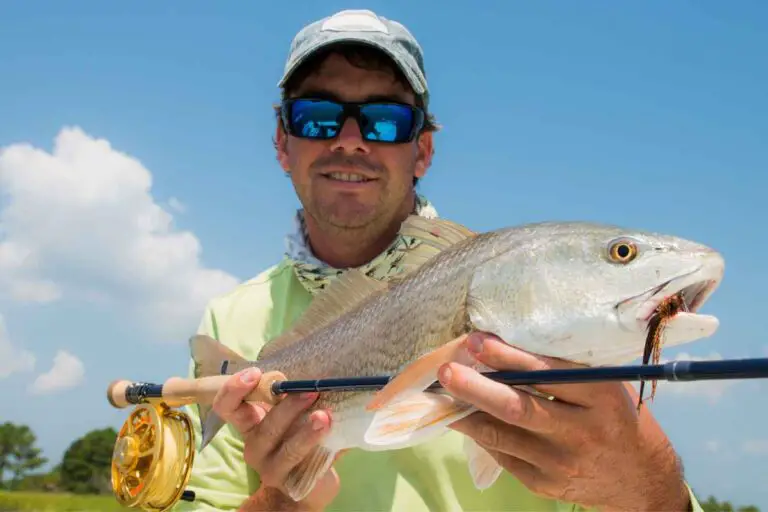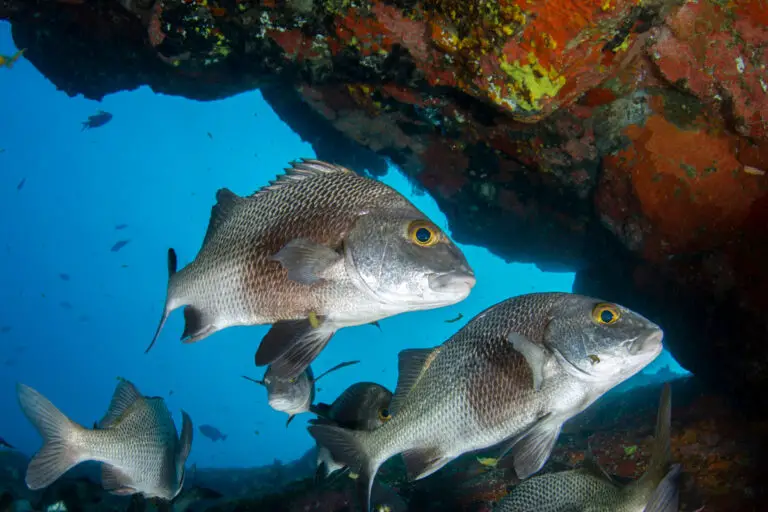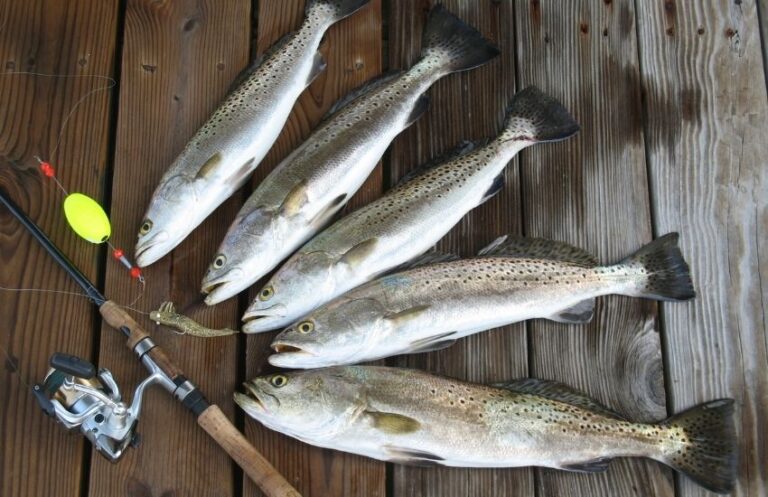Louisiana Saltwater Fish Limits [2023]: Top 48 Game Fish
Estimated reading time: 12 minutes
Louisiana boasts a diverse range of saltwater fish species, drawing anglers from across the globe. To ensure the sustainability of these species and preserve the ecosystem, it’s crucial to understand Louisiana’s regulations on saltwater fish limits. Below are the most common Louisiana saltwater fish size limits for 48 popular game fish:
- Red Drum (Bull Red): 16″ Min. – 27″ Max, Possession Limit: 5 fish per person per day
- Spotted Seatrout: 12″ Min, Possession Limit: 25 fish per person per day
- Sheepshead: No Min, No Daily Possession Limit
- Southern Flounder: No Min, Possession Limit: 10 fish per person per day
- Cobia: 37″ Min, Possession Limit: 2 fish per person per day
Louisiana Saltwater Fish Limit Definitions
Saltwater fishing size limits are designed to maintain optimum yields for recreational anglers statewide. In Louisiana saltwater fishing, bag limits are established and bagged by species and, in some cases, size restrictions.
Each is regulated and enforced by the Louisiana Department of Wildlife and Fisheries. Anglers are subject to fines for fishing and conservation violations.
- Bag limit – The maximum number of fish a person may catch in one day or per period. It’s usually limited to per person, per day, and on rare occasions, it includes a daily vessel limit.
- Creel limit – There is no difference between the bag and creel limits for Louisiana fishing.
- Minimum size limit – The saltwater fishing regulations state that the fish must be larger than a certain size to be taken. These rules allow fish to reach a size where they can reproduce before being harvested.
- Slot limit – Slot limits are similar to the minimum size restriction in that there is both a maximum and minimum size limit and only fish that fit within the slot may be taken. This classification helps developing young fish mature while also shielding larger spawning fish.
- Season – Times of year open or closed to saltwater fishing for a certain species. A closed season protects fish from harvest during sensitive times of the year, such as spawning periods or heavy fishing.
Louisiana Regulations for Recreational Saltwater Fishing
The Louisiana Department of Wildlife and Fisheries sets the state’s recreational saltwater fishing regulations. These regulations include daily bag limits, size limits, and possession limits for different fish species. It is important for recreational fishermen to be aware of these regulations to avoid penalties and fines for breaking the law.
Federal Regulations
Some species of fish have federal regulations that may supersede Louisiana regulations. For example, fishermen planning to harvest tuna must know the most current federal regulations, including size, bag limits, and seasons.
Recreational Offshore Landing Permit
In addition, recreational fishermen who wish to possess certain species of fish in Louisiana waters must obtain a Recreational Offshore Landing Permit (ROLP) and required licenses. The ROLP is necessary for those who plan to fish for and possess certain federally managed species, such as red snapper, in Louisiana waters.
By following the regulations set forth by the LDWF, recreational fishermen can help ensure the sustainability of fish populations and maintain the health of the state’s saltwater ecosystem. It is essential to stay up-to-date on the latest regulations to avoid penalties and fines for breaking the law.
Louisiana Saltwater Fishing Size Limits
What are Louisiana Saltwater Fish Limits?
Louisiana has established regulations regarding size and possession limits for saltwater fish caught recreationally in Louisiana territorial waters.
Based on biological and technical data, these limits are set by the Wildlife and Fisheries Commission to ensure the sustainability of fish populations and protect the ecosystem.
Size Limits for Saltwater Fish
Unless otherwise established, there are no size limits for species not listed. However, for some species, there are specific size limits that recreational anglers must adhere to.
For example, the spotted seatrout must be at least 12 inches long. No more than two speckled trout exceeding 25 inches in total length can be kept daily in a defined area of Cameron and Calcasieu parishes in southwestern Louisiana.
Possession Limits for Saltwater Fish
Unless otherwise noted, possession limits for saltwater fish are the same as the daily bag limit.
For example, the daily bag limit for speckled trout is 25 fish per person, and the possession limit is 25 fish per person.
Seasons and Regulations
Seasons and regulations may differ in federal waters off Louisiana’s coast. Recreational anglers are advised to check the latest seasons and limits, gear restrictions and requirements, and prohibited species before fishing in Louisiana’s saltwater areas.
Penalties for Violating Saltwater Fish Limits
Violating saltwater fish limits in Louisiana can result in fines, confiscation of equipment, and even imprisonment. The severity of the penalty depends on the nature and extent of the violation.
Recreational anglers must follow the established size and possession limits to avoid legal consequences.
Louisiana Saltwater Fish Limits: Handy Quick Chart
It is essential for anglers to be aware of the size limitations for saltwater fish in Louisiana to avoid hefty fines and suspension of their fishing privileges. A brief chart outlining the size limits for various popular saltwater fish species in Louisiana is provided below:
| Species Name | Minimum Size Limit | Bag & Possession Limit | Season |
|---|---|---|---|
| Almaco Jack | None | 20 per person applied to 20 reef fish aggregate | Open year-round in state waters |
| Amberjack, Greater | 34 inches FL | 1 fish per person | Closed: Jan 1 – Jul 31 Open: Aug 1 – Oct 31 Closed: Nov 1 – Dec 31 |
| Amberjack, Lesser | 14-22 inch slot limit | 5 fish per person; combined total with banded rudderfish | Open year-round in state waters |
| Cobia (Ling or Lemonfish) | 36 inches FL | 2 fish per person | Open year-round in state waters |
| Drum, Black | 16-27 inch TL slot limit | 5 fish per person with 1 over 27 inch maximum TL | Open year-round in state waters |
| Drum, Red (Federal Waters) | Catch and release only | Take or possession is prohibited on federal waters | Closed year-round in federal waters |
| Drum, Red (State Waters) | 16-27 inch TL slot limit | 5 fish per person with 1 over 27 inch maximum TL; Recreational anglers have a 10 fish per person possession limit on land, 5 fish possession limit on water | Open year-round in state waters |
| Grouper, Black | 24 inch TL | 4 fish per person applied to 4 grouper aggregate; only 1 speckled hind and 1 warsaw grouper per vessel; only 2 red grouper per person within aggregate bag limit | Open: Jan 1 – Jan 31 in state waters Closed: Feb 1 – Mar 31 seaward of 20-fathom boundary Open: Apr 1 – Dec 31 in state waters |
| Grouper, Gag | 24 inch TL | 2 fish per person applied to 4 grouper aggregate; only 1 speckled hind and 1 warsaw grouper per vessel; only 2 red grouper per person within aggregate bag limit | Closed: Jan 1 – May 30 in state waters Open: Jun 1 – Dec 31 in state waters |
| Grouper, Goliath Nassau | Catch and release only | Take or possession is prohibited on federal waters | Closed year-round in all waters |
| Grouper, Red & Yellowfin | 20 inch TL | 2 fish per person applied to 4 grouper aggregate; only 1 speckled hind and 1 warsaw grouper per vessel; only 2 gag grouper per person within aggregate bag limit | Open: Jan 1 – Jan 31 in state waters Closed: Feb 1 – Mar 31 seaward of 20-fathom boundary Open: Apr 1 – Dec 31 in state waters |
| Grouper, Scamp | 16 inch TL | 4 fish per person applied to 4 grouper aggregate; only 1 speckled hind and 1 warsaw grouper per vessel; only 2 red grouper per person and only 2 gag grouper per person within aggregate bag limit | Open: Jan 1 – Jan 31 in state waters Closed: Feb 1 – Mar 31 seaward of 20-fathom boundary Open: Apr 1 – Dec 31 in state waters |
| Hogfish | 14 inch FL | 5 fish per person | Open year-round in state waters |
| King Mackerel | 24 inch FL | 3 fish per person | Open year-round in state waters |
| Marlin, Blue | 99 inch lower jaw FL | None | Open year-round in state waters |
| Marlin, White | 66 inch lower jaw FL | None | Open year-round in state waters |
| Seabass, Black | None | None | Open year-round in state waters |
| Shark, Atlantic Sharpnose, Bonnethead | None | 1 fish per person per day in aggregate; possessing any shark in excess of bag limit is prohibited | Open year-round in state waters except Apr 1 – Jun 30 |
| Shark, Shortfin Mako | Males: 71 inch FL Females: 83 inch FL | 1 fish per vessel per trip in aggregate; possessing any shark in excess of bag limit is prohibited | Open year-round in state waters except Apr 1 – Jun 30 |
| Shark, Small Coastal, Large Coastal, Pelagic (except Silky, Sandbar, and Shortfin Mako) | 54 inch FL | 1 fish per vessel per trip in aggregate; possessing any shark in excess of bag limit is prohibited | Open year-round in state waters except Apr 1 – Jun 30 |
| Sheepshead | None | None | Open year-round in state waters |
| Snapper, Cubera, Grey (Mangrove), Yellowtail | 12 inch TL | 10 per person applied to 10 snapper aggregate | Open year-round in state waters |
| Snapper, Lane | 8 inch TL | 20 per person applied to 20 reef fish aggregate | Open year-round in state waters, or until annual catch limit is projected to be met |
| Snapper, Mutton | 18 inch TL | 5 per person applied to 10 snapper aggregate | Open year-round in state waters |
| Snapper, Queen, Blackfin, Silk, Wenchman | None | 10 per person applied to 10 snapper aggregate | Open year-round in state waters |
| Snapper, Red | 16 inch TL | 3 fish per person | Closed: Jan 1 – May 25 in state and fed waters Open: May 27 until recreational landings approach LA allocations. Weekends only plus Memorial Day and July 4th in both state and federal waters. |
| Snapper, Vermilion | 10 inch TL | 10 per person applied to 20 reef fish aggregate | Open year-round in state waters |
| Southern Flounder | None | 10 fish per person in state waters | Open: Jan 1 – Oct 14 Closed: Oct 15 – Nov 30 Open: Dec 1 – Dec 31 |
| Spanish Mackerel | 12 inch FL | 15 fish per person | Open year-round in state waters |
| Speckled Trout (Spotted Seatrout) | 12 inch TL | Statewide except noted: 25 fish per person Cameron Parish: 15 fish per person with 2 over 25 inch TL Calcasieu Parish: 15 fish per person with 2 over 25 inch TL | Open year-round in state waters |
| Striped Mullet | None | 100 lbs per person | Open year-round in state waters |
| Swordfish | 29 inch carcass length or 33 lbs dressed weight | 5 fish per vessel per trip | Open year-round in state waters. You must report all recreational landings to NOAA Fisheries within 24 hours of landing at the dock. |
| Tilefish, Goldface, Blackline, Anchor, Blueline | None | 20 per person applied to 20 reef fish aggregate | Open year-round in state waters |
| Triggerfish, Gray | 15 inch FL | 20 per person applied to 20 reef fish aggregate | Closed: Jan 1 – Feb 28 Open: Mar 1 – May 31 Closed: Jun 1 – Jul 31 Open: Aug 1 – Dec 31 or until annual catch limit is projected to be met |
| Tripletail | 18 inch TL | 5 fish per person | Open year-round in state waters |
| Tuna, Bigeye | 27 inch curved FL | None | Open year-round in state waters |
| Tuna, Bluefin | 73 inch curved FL | 1 trophy per vessel per year, accidently caught, while trophy season | Open: Jan1 until state quota is met |
| Tuna, Yellowfin | 27 inch curved FL | 3 fish per person | Open year-round in state waters |
It is important to note that unless otherwise established, no size limits exist for species not listed. Additionally, possession limits for saltwater fish are the same as the daily bag limit unless otherwise noted.
To ensure compliance with Louisiana saltwater fish size limits, anglers can take several steps:
- Measure fish accurately: Use a ruler or measuring tape to measure the fish from the snout’s tip to the tail’s end.
- Release undersized fish: Any fish not meeting the minimum size limit should be released immediately.
- Stay current on regulations: Regulations and seasons may differ in federal waters off Louisiana’s coast, so staying informed and up to date is important.
All Prohibited Fish Species
We have the list of prohibited species conveniently listed here for you. Possessing fish caught of these species is illegal, and harvesting these species is strictly prohibited. There are associated fines for violations.
- All whales, Atlantic angel shark, Basking shark, Bigeye sixgill shark, Bigeye sand tiger shark, Bigeye thresher shark, Bignose shark, Caribbean reef shark, Caribbean sharpnose shark, Dolphin (mammal), Dusky shark, Galapagos shark, Goliath grouper, Gulf sturgeon (Acipenser oxyrinchus desotoi), Largetooth sawfish, Longfin mako shark, Nassau grouper, Narrowtooth shark, Night shark, Sand tiger shark, Sea turtles, Sevengill shark, Sixgill shark, Smalltail shark, Smalltooth sawfish, Whale shark, White shark.
- Daily Bag: 0, catch and release only; harvest prohibited.
What Are The Louisiana Saltwater Fish Limits?
Definition of Louisiana Saltwater Fishing Size Limits
The government regulates the size of fish caught and kept in Louisiana waters. These rules specify the smallest and largest sizes of fish that are allowed to be kept. These rules are important because they help protect the fish and ensure there will still be enough for people to catch in the future.
Types of Fish with Size Limits
Louisiana has various types of fish with size limits, including cobia, red snapper, and yellowfin tuna. For example, cobia must be at least 36 inches in fork length. Red snapper must be at least 16 inches in total length. It is important to check the LDWF website for the most up-to-date information on size limits for specific fish species.
How to Measure Fish According to Louisiana Saltwater Fishing Size Limits
To measure fish according to Louisiana saltwater fishing size limits, anglers should measure the fish from the tip of the nose to the end of the tail (total length). Alternatively, depending on the species, from the tip of the nose to the fork in the tail (fork length). It is important to use a measuring device that is accurate and approved by the LDWF.

Fork Length vs. Total Length
Two methods used to measure fish are fork length and the total length, and they differ in what parts of the fish they include in the measurement.
Anglers measure fork length from the tip of the fish’s snout to the center point of the tail’s fork, typically used for fish with forked tails, such as tuna or swordfish.
In contrast, anglers measure the total length from the snout’s tip to the tail’s end, commonly used for fish with a round or square tail, like red snapper or grouper.
The main difference between fork length and total length is that fork length measures only a portion of the fish’s tail, while total length includes the full length.
What to Do with Fish That Don’t Meet Louisiana Saltwater Fishing Size Limits
If it does not meet Louisiana saltwater fishing size limits, a fish must be released immediately and unharmed back into the water.
It is important to handle the fish carefully and minimize the time it is out of the water to increase its chances of survival. Anglers should also avoid catching and releasing the same fish multiple times, as this can increase the fish’s stress levels and decrease its chances of survival.
Louisiana Fishing License Options For Saltwater
Saltwater Package License Prices
Louisiana offers a variety of fishing license options for saltwater fishing enthusiasts. Obtaining the appropriate fishing license before engaging in recreational fishing is essential to avoid penalties. Here are some of the fishing license options available in Louisiana for saltwater fishing enthusiasts:
Saltwater Fishing License Combination: This license combination includes a Basic Fishing License and a Saltwater Fishing License. It is available for $13.50 for residents and $60.00 for non-residents.
Saltwater Fishing License: This license is available for those who prefer to fish only in saltwater. It costs $10.00 for residents and $60.00 for non-residents.
Seven-day Saltwater Fishing License: This license is available for non-residents only and costs $30.00.
Charter Passenger License: Anglers can purchase a Charter Passenger License for $10.00, which allows them to fish on a charter boat in Louisiana’s saltwater areas.
It’s important to note that some special licenses, such as Lifetime Licenses or Senior Hunting/Fishing Licenses, may also include recreational saltwater fishing privileges. By obtaining the appropriate fishing license, anglers can enjoy Louisiana’s abundant saltwater fishing opportunities without facing legal repercussions.
Louisiana offers several fishing license options for individuals who enjoy saltwater fishing.
- Saltwater Fishing License Combination includes a Basic and Saltwater Fishing License.
- Saltwater Fishing License is available for those who prefer to fish only in saltwater.
- Seven-day Saltwater Fishing License is available for non-residents
- Charter Passenger License allows fishing on a charter boat in Louisiana’s saltwater areas
- Some special licenses may include recreational saltwater fishing privileges
Obtaining the appropriate fishing license is crucial to avoid legal repercussions.
Louisiana Fishing Regulations Saltwater
Regarding recreational fishing in Louisiana, there are specific regulations that anglers must follow. These regulations are in place to ensure that fish populations remain healthy and sustainable for future generations. This section will cover the regulations specifically related to saltwater fishing in Louisiana.
Who Enforces Louisiana Saltwater Fish Limits?
The LDWF enforces state fishing regulations in Louisiana. This includes monitoring and enforcing size and bag limits for various fish species.
How are Louisiana Saltwater Fish Limits Enforced?
The LDWF uses various methods to enforce saltwater fish limits in Louisiana. This includes regular patrols by LDWF agents and inspections of boats and catches at boat ramps and other access points. Additionally, the LDWF has established a toll-free hotline for anglers to report suspected violations.
Anglers should also be aware that the LDWF has the authority to inspect any boat, vehicle, or other container believed to be used to transport fish. This means that even if an angler is not caught violating fish limits, they could still face the consequences if they are found to possess more fish than allowed by law.
What are the Consequences of Violating Louisiana Saltwater Fish Limits?
Violating saltwater fish limits in Louisiana can result in fines and the loss of fishing privileges. The specific consequences depend on the severity of the violation and the number of previous offenses. For example, a first-time offender may face fines of up to $350, while a third-time offender may face fines of up to $1,000 and the loss of fishing privileges for up to three years.
Anglers should also be aware that some fish species have specific size and possession limits that are more strictly enforced. For example, the spotted sea trout has a possession limit of 15 fish per day, with no more than two fish exceeding 25 inches in total length. Violating this limit can result in fines of up to $500 and the loss of fishing privileges for up to one year.
Frequently Asked Questions
Here are some frequently asked questions about Louisiana saltwater fish limits:
Unless otherwise noted, possession limits for saltwater fish are the same as the daily bag limit. The daily bag limit for most saltwater fish species is 25 per person daily. However, there are some exceptions. For example, If you catch spotted seatrout in Cameron and Calcasieu parishes in southwestern Louisiana, you can keep up to 15 fish per day, but only two can be longer than 25 inches.
Unless otherwise established, there are no size limits for most saltwater fish species in Louisiana. However, there are some exceptions. For example, a red drum must be between 16 and 27 inches long to be harvested, and no more than one per person per day may exceed 27 inches in total length.
There are some prohibited species for recreational saltwater fishing in Louisiana. The federally listed threatened and endangered or prohibited species listed below are off limits for fishing or recreational take. These include silky sharks, sandbar sharks, sixgill sharks, ridgeback sharks, and other prohibited species.
No, Louisiana has specific seasons and regulations for saltwater fishing. The seasons and regulations may differ in federal waters off Louisiana’s coast. It is important to check the latest seasons and limits, gear restrictions and requirements and prohibited species before going saltwater fishing in Louisiana.
Conclusion
The Louisiana Department of Wildlife and Fisheries (LDWF) has set recreational and commercial harvest regulations to protect fish populations and the ecosystem. These include daily bag, possession, and size limits for different fish species. Violations can result in fines, equipment confiscation, and even imprisonment.
Important Points:
- Louisiana has specific size and possession limits for various saltwater fish species, such as red drum, spotted seatrout, and cobia.
- Recreational saltwater anglers must know these state and federal laws to avoid penalties and fines.
- The LDWF enforces these regulations through regular patrols, inspections of boats and catches, and a toll-free hotline for reporting suspected violations.
Tips for the recreational saltwater angler:
- Measure fish accurately and release undersized fish immediately.
- Stay informed and current on regulations and seasons, which may differ in federal waters off Louisiana’s coast.
- Obtain the appropriate Louisiana saltwater license to avoid legal repercussions.







